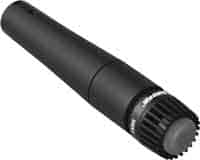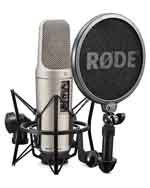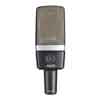Summary and Rating: Rode NT1A vs Rode NT2A
NT1-A
NT2-A
Our Overall Rating
4.6 (out of 5)
4.9 (out of 5)
Pick-up patterns
Cardioid (20Hz – 20 kHz)
Cardioid (20 Hz – 20 kHz)
Figure-8 (20 Hz – 20 kHz)
Omnidirectional (20 Hz – 20 kHz)
Self-noise
5 dB(A)
7 dB(A)
Max SPL
137 dB
147 dB
Pads and Filters
none
Pad: -5 and -10 dB
Filter: 40 and 80 Hz (High Pass)
Weight
326 g
860 g
Pros
Pros NT1-A
- the lowest self-noise of any mic in its class
- elegant, balanced sound with nice details in the high frequencies without being unnatural
- Great value
- comes with shock mount and pop filter
Pros NT2-A
- very low self-noise
- elegant, balanced sound with great detail in the high end. Similar sonic signature to the NT1A with added warm love from its capsule.
- switchable polar patterns make it extremely versatile
- comes with shock mount and pop filter
Cons
Cons NT1-A
- Design may lack sex appeal
- No carry case included
Cons NT2-A
- May sag weaker mic stands with its weight
- Design may lack sex appeal
- No carry case included
Rode NT1-A
Rode NT2-A
Bottom Line
Both are fine choices for your studio offering similar sonic signatures: open, balanced, with excellent detail in the high end.
The NT1-A offers simplicity and great value. The NT2-A offers versatility and a slightly sweeter sound.
They both outclass their competition in the area of low self-noise.
It’s like the mic is not even there! The Rode NT1A and NT2A mics both win big in area of low self-noise. But there’s more to each of them than being quiet as mice.
This review is for anyone considering one of these mics who would like to hear them side by side and compare features. We test them below so you can hear the results with your own ears.
For more audio equipment reviews, see here.
What’s in the box?
As you can see in the above video, both boxes, the Rode NT1-A and NT2-A, include the SM6 shock mount and pop filter, a 6-meter cable, and a little dust cover pouch.
Who are these mics for?
Those looking for a quality condenser microphone with a balanced, modern, detailed sound to record almost anything in the studio will be pleased with the Rode NT1A and NT2A.
If you’re recording quiet instruments or intimate vocals, these mics are outstanding. The low self-noise of these Rodes makes them ideal for such applications. (assuming your preamp is sufficient)
For those with a tighter budget, the NT1A provides elegant sound with a simple cardioid, minimal build.
The NT2A, with its switchable polar patterns and attenuation pads, provides a slightly sweeter sound signature and more versatility. For those who would like the option to record ambient spaces, ensembles, live recordings, mid-side techniques – any kind of multi-directional recording – the NT2A is a good fit.
Who are these mics NOT for?
These mics are not suited for the following situations:
- the live stage (a dynamic mic like the Sennheiser e935, or Shure SM57 would be recommended.)
- untreated, noisy environments
It is worth noting that the market for condenser microphones under $500 is crowded indeed, with many great choices available. Here are some alternatives we would use:
Alternatives to the Rode NT1-A
Alternatives to the Rode NT2-A
Build / Design
Neither of these mics is sexy or novel to look at, but thankfully they make up for that with their mechanical innards.
Both microphones are redesigns of their predecessors (NT1 and NT2, respectively). The redesigns improved performance and lowered the cost considerably.
The NT1A has a one-inch gold-sputtered mylar diaphragm, hanging in a rubber casing which is further secured in a metal housing with a satin nickel finish. It has no onboard switches for roll-off or polar patterns.
The NT2-A uses the same capsule as the Rode K2 tube condenser, also sporting a 1-inch gold-sputtered diaphragm. One of the first things you notice is its weight (860 g) – nearly three times heavier than the NT1A.
Self-noise and Max SPL
Both mics have impressively low self-noise. The NT1A measures at 5 dBA and the NT2A only a bit more noise with 7 dBA. None of the competitive alternative mics can compete with those numbers.
And they both can handle the loud stuff! The NT1A has a max SPL of 137 dB. The NT2A has a max SPL of 147 dB without attenuation switches on and 157 dB with the pad on. If you’re going above 157 dB max SPL in your studio, well, I guess you’re recording explosions or jet engines.
The obvious difference on the NT2A is the onboard switches on the front of the mic. The onboard switches include one for polar pattern, with which one can switch between cardioid, figure-8, and omnidirectional polar patterns. The front panel also includes switches for a high-pass filter with the choice of 40 Hz or 80 Hz as well as attenuation pads of 5dB or 10dB.
Sound
Rode NT1A vs NT2A Frequency Response
In general, both mics have a relatively neutral frequency response lacking unnatural compensation in any range.
As you can see in the chart below, the differences between the microphones in frequency response are subtle. The NT2A has a slight boost in the middle around 400 Hz and a little more brilliance in the 500-700 kHz range. The NT1A offers a little more from 100-200 Hz and slightly more air at the top.
Frequency Response Chart: Rode NT1A vs Rode NT2A
(Cardioid)



Rode NT1A vs NT2A: The Test
We used a Universal Audio Apollo Solo powered Interface recorded with Logic Pro X. There is no EQ or compression applied to any of the audio clips here. We adjusted the gain from the audio interface to taste. The guitars were a Martin steel-string acoustic guitar and Fender Strat plugged into 40 Watt Fender Champ.
Full disclosure: We fully acknowledge that there is no one way to use a microphone. Mic placement, how you play or sing, not to mention EQ, compression, Impedance, and preamp settings can all have dramatic effects on the final result.
Both mics were tested switched on cardioid polar pattern.
Sung Vocals Test
Spoken Vocals Test: Plosives, Sibilance
Acoustic guitar test
Electric Guitar (Clean) Test

Electric Guitar (Distortion) Test
Conclusions about the Sound
To my ears, both mics sound nicely balanced with loads of detail in the higher frequencies with a bottom end to match. The sonic signature is very similar: natural sound with gentle assistance. The NT2A shows an ever-so-slight warmer edge due to the K2 capsule with noticeably more brilliance (3-7 kHz).
Both mics lack the excessive air boost or harsh upper mids shared by many competitors. You can EQ without needing to compensate for the mic’s character.
And as advertised, the super-low self-noise is impressive. While recording, you notice it right away – no hiss, at all. The silence in between sounds like you stopped tracking.
FAQ
What is a Condenser Microphone?
Both the Rode NT1A and NT2A are condenser microphones. Within the guts of these mics, there is a capsule containing a delicate, ever-so thin strip of metal, called a diaphragm, sitting very close to a solid metal backplate.
When sound enters the capsule, the diaphragm moves a certain distance away from the solid metal plate. That distance is measured and converted into an electrical signal.
The most commonly used mics are dynamic, condenser, and ribbon microphones. Each uses a different mechanical configuration to create an electrical signal.
What is Phantom Power?
The capsule of a condenser microphone requires external power to create its electrical signal. This required signal is known as “phantom power” (usually 48V). Most audio interfaces and preamps provide optional phantom power for recording.
Why would you ever need attenuation pads on the mic itself?
The Rode NT2-A can handle 147 dB max SPL without the attenuation pads on. Your preamps however, might not be able to handle that much. In this case, with the pads on, you can reduce the amount of sound to a manageable level for your preamps.
What they say about the NT1A & NT2A
We asked around the biz and got a few words from some pros who use this mic:
I teach singers online with the NT1-A. I need to communicate details and this mic delivers.
Megan Langan, Singer
People dis this thing because it’s so popular and cheap. [NT1-A] But you’d be hard pressed to find an entry level mic that performs like it. With the right mic placement – it’s a gem. If track hiss is an issue, it’s my go-to.
Rodney Langton, Producer
I record a wide range with this mic [NT2-A]: vocal ensembles, shakers, tambourines, piano, acoustic guitars. Thumbs up for versatility and performance.
Michael Watson, Sound Engineer
I use the Rode NT2-A to record opera singers, all different voice types, accompanied with piano. The results are superb with no noise in the tracks. The different polar patterns are a huge asset.
Ed Alford, Classical Pianist
Related or Mentioned Gear
Rode NT1-A Microphone
Rode NT2-A Microphone
AKG C214 – Alternative to the NT1-A with a similar sound signature.
Aston Origin – Alternative to the Rode NT1-A, excellent sound and aesthetically pleasing.
AKG P420 – a budget alternative to the NT2-A(See here for all of our audio gear tests )

Warm Audio 47-jr – Alternative to the NT2-A, a multi-polar condenser modelled after the Neumann UA-47
Shure SM57 – industry-standard utility dynamic microphone. For more information on microphone choice see here.

Sennheiser e935 – a dynamic mic ideal for live vocals. See here for more info on this mic.
Questions or Comments?
Join the discussion here on Facebook.






